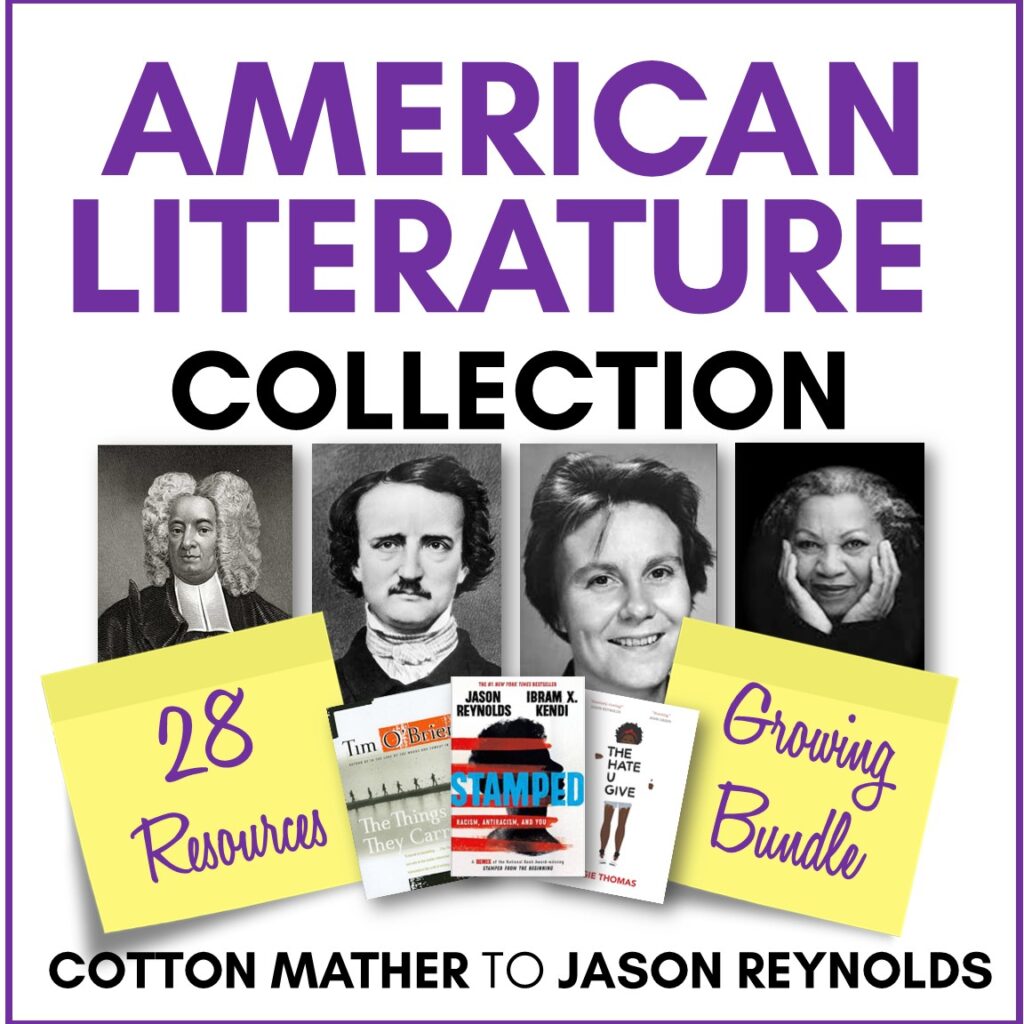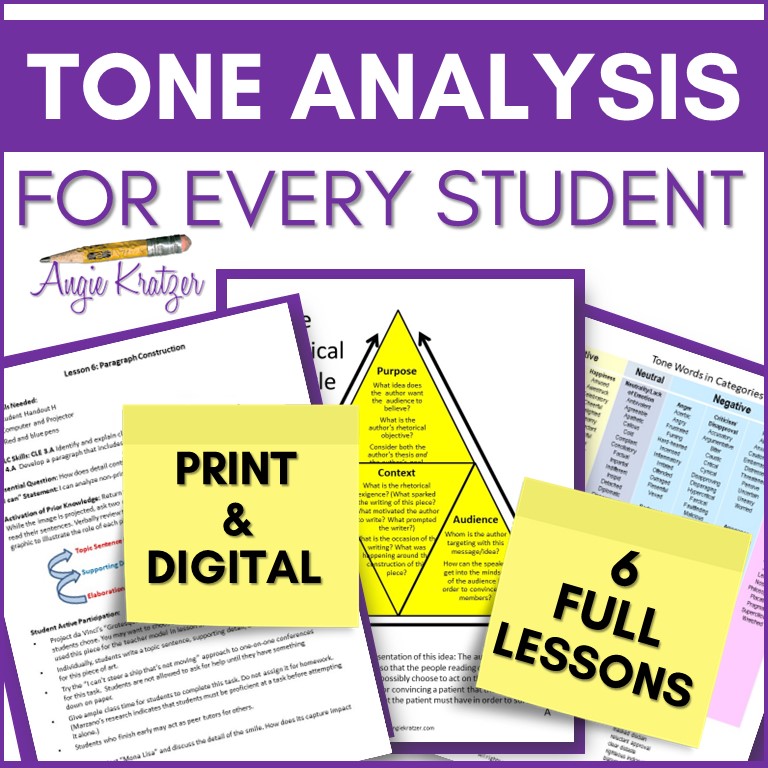How in the nation are we supposed to squeeze an American Literature survey into AP Language? In North Carolina, it’s a requirement. In fact, my district’s scheduling label for AP English Language & Composition is AP English 11 because the course has to hit two things—AP standards AND the NC Standard Course of Study. Whew. That’s a lot.

Something Has to Give: Which Content Gets Cut–AP Language or American Lit?
I think we can all agree that we are not going to do justice to either content set if we try to teach each fully. It’s just not going to happen, so each of us has to make a decision: Am I teaching an American Lit class with AP Lang standards woven in, or am I teaching AP Language with American Lit woven in?
I’m not sure there’s a wrong answer, but I’m pretty sure each of us is already doing one or the other, probably the latter. Going on that assumption, there are ways to have AP Lang as the base, backbone, and foundation and weave, mix in, and layer American Literature. There. Now we have all the metaphors and can talk about the how.
Focus on the Non Fiction within American Literature
Does fiction even belong in AP Language? Yes it does, and you can read all about it here. BUT the course is designed for non fiction, so that’s where we have to live most of the time.
Students can get a sense of style and content by digging in to the nonfiction pieces within each period. Poe wrote both short stories and reviews. Mark Twain wrote Huck Finn and humorous articles. Frederick Douglass and Susan B. Anthony were writing letters back and forth at the same time.
If you must get in the fiction, do so with short pieces and focus on the author’s writing style. Review the impact of sentence structure with “A Rose for Emily” instead of A Light in August. Hit Romanticism with “The Minister’s Black Veil” instead of The Scarlet Letter. Students will have exposure to many of the elements of the period without the extended torture of Hawthorne.
If there is a time for a full-length book, use something that can cross over, like creative non-fiction. Think The Things They Carried. Tim O’Brien takes much license in this memoir-ish account of his time in Vietnam, and it’s PERFECT for looking at rhetorical choices. The whole thing is written in chaptered vignettes, and I introduce a specific rhetorical mode (a.k.a. mode of discourse or academic genre) in each chapter. Students look at the modes as both frames and devices and even write in each one. Read more about my approach to the book here.
Get the Big Picture of American Lit
If the plan is to hit every agreed-upon “period” in American literature, anthologies and textbooks are going to point to dead, White, privileged men. Go broader and go deeper.
Within each period, look for women of color who published (in any form—letters, speeches, etc.) Search out pieces that were transcribed. I’m a big fan of Indigenous speeches that were given in a Native tongue and translated. (Technically, AP Lang will never use a piece that was not originally written or spoken in English, but I think we can get away with it.)
Also floating around out there in the back wood of the Interwebs are Native speeches and letters that were written in English. I recently discovered a speech Ruth Muskrat Bronson gave to President Coolidge in 1923. I like it for work on tone subtlety.
Don’t forget, too, that Indigenous literature is still happening! Consider things like speeches and letters that were produced during the height of the Keystone Pipeline protests.
How it Might Look
Indigenous Literature: speeches by chiefs protesting westward expansion and opinion pieces produced during the Alaska Pipeline protests (Keep in mind, though, that Native literature can stand on its own without being framed by colonization.)
Revolutionary Literature: Read Phyllis Wheatley’s letters, Thomas Payne’s Common Sense, and Patrick Henry’s “Speech to the Virginia Convention.”
Romanticism: Teach the power of allusion with “The Raven”, get in one exemplary short story like “The Devil and Tom Walker,” and dig into a piece Poe wrote in 1845 for The Broadway Review.
Transcendentalism: Get in an excerpt from Thoreau’s “Walden” and Emerson’s “Self Reliance.”
Although poetry is rarely taught in AP Language, I always spend a day on “Thanatopsis;” it hits features of both Romanticism and Transcendentalism, literary periods that crossed over each other.
Civil War: Study letters to and from Susan B. Anthony and Frederick Douglass, soldiers’ letters home, and Lincoln’s “Gettysburg Address.”
Realism: Enjoy a humorous article by Mark Twain and one Jack London short story.
Turn of the 20th Century: Look at syntax within “A Rose for Emily,” and bring in an excerpt from The Awakening. You can find the full text of the novel here.
To stay current, use a book like Stamped: Racism, Antiracism, and You. In my own unit, I pull in letters, speeches, and articles written by the likes of Phyllis Wheatley, Thomas Jefferson, and W.E.B. DuBois. I think of the book as a one-stop shop.
What to Squeeze
If you can only get in two full-length books, I’m a fan of The Things They Carried and Stamped, and I see a lot of online discussion about Educated and Just Mercy right now among AP Lang teachers.
If you are on a full-year schedule in a school with a homework culture, drop in books that students read outside of class. My favorites are The Catcher in the Rye and The Bluest Eye, but teachers have a love-hate relationship with those.
If your school has an outside reading program, offer incentives for students to read works like Their Eyes Were Watching God.
In North Carolina, the assessment students take at the end of eleventh grade is not author-specific or even period-specific; it’s all about skills. They are asked to produce constructed responses that are based on short passages they have right in front of them and answer questions on the same. Be sure to check your end-of-course test content before launching into the design of your pacing.

My take on weaving the two is that AP Language is the priority, and we use American literature as a way to teach the AP Lang skills. I’ve begun a growing collection of all my American literature resources; take a look to see if it’s a good fit for you. There will be eventually be resources for every major period. It sits at 28 resources right now, but there is much more to come. Anyone who purchases the bundle now gets all future products for free.
This post contains affiliate links.
Want to stay in touch? Subscribe to Angie’s email list and immediately get six free lesson plans to help you teach tone.


